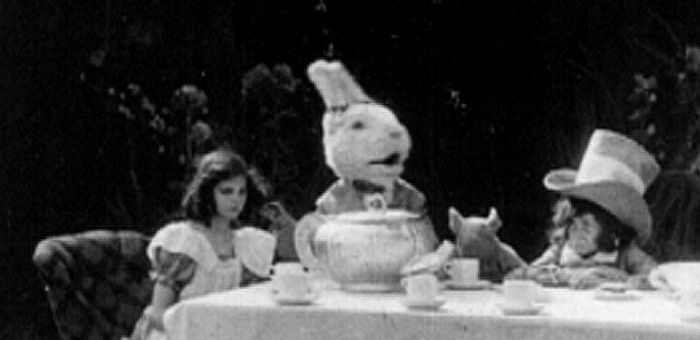By 1910, No One Had Cracked the Film Adaptation Code

Note: This is the fifty-seventh in a series of historical/critical essays examining the best in film from each year. Essentially, I am watching films from the beginning of cinematic history that interest me and/or hold some critical or cultural impact. My personal, living list of favorites is being created at Mubi, showcasing five films per year. All this being explained, what follows is an examination of my second favorite 1910 film, ALICE’S ADVENTURES IN WONDERLAND, directed by Edwin S. Porter.
Adaptation must be difficult. Capturing the spirit of source material while creating a unique form is not a task approached lightly. It’s probably made even worse when you have about 15 minutes (or less) to fit a full novel into cinematic form. And yet that was done with reckless abandon during the early years of cinema as filmmakers latched onto familiar images, stories, and concepts while they figured out the new artistic medium. Of course, adaptation has continued to be a central part of film, but it took some time before technology was even at a place where stories from another medium could even begin to be told “accurately,” let alone truly creatively.

That’s how you get the 1910 THE WONDERFUL WIZARD OF OZ adaptation, a creative yet relatively unfaithful film based on L. Frank Baum’s novel of the same name. And that’s how you get the 1910 ALICE’S ADVENTURES IN WONDERLAND, a relatively faithful yet, well, not super creative film based on Lewis Carroll’s novel of the same name.
Carroll’s story had already been adapted for film once before, in 1903 (which was actually one of my favorite films of that year), and Edwin S. Porter’s Edison film is only slightly more ambitious than Cecil Hepworth and Percy Stow’s British production. Maybe it’s because Porter was on his way out from Edison; as near as I can tell, he left the studio in 1909. Since it released in March 1910, ALICE’S ADVENTURES IN WONDERLAND may have been one of his final films with Edison, before he went on to work with the Paramount predecessor Famous Players Film Company.

It’s a dangerous thing to say a creator was “lazy” or not really “trying” with a commercial product because the business and creative realities of a project simply aren’t known. Considering Porter’s fastidiousness, it’s not likely he “sabotaged” the project because of he was fed up with Edison. But it is possible that Porter did not utilize his chameleon directing style to render ALICE’S ADVENTURES IN WONDERLAND as unique as it could be. Porter never had a tremendous fantastic eye, but when faced with certain subject matter, he could throw away innovations he had used in previous films and come up with something else to serve the project.
Ultimately, it was Porter’s realism and bluntness that probably informed ALICE’S ADVENTURES IN WONDERLAND by-the-book approach, literally. And it also probably influenced the stolid, underwhelming “fantastical” imagery. When compared to the otherworldly efforts of French filmmakers like Georges Méliès, or even American Otis Turner of THE WONDERFUL WIZARD OF OZ, the visuals of ALICE’S ADVENTURES are down-to-earth.

The white rabbit, for example, is a little child in a rabbit suit, which is in its own way a charming interpretation. And after Alice is led down the rabbit hole, her fall is represented by a scrolling cutout of a tunnel while Gladys Hulette (who plays Alice) stands still. It’s actually a solid effect for 1910. But now would be a good time to mention that Porter’s trademark style comes into play pretty early. As mentioned, his films weren’t necessarily united by any specific camera techniques or framing. But they were united by his tendency to linger on mundane sequences for too long. Just over four minutes of the film’s 14-minute run time is spent in the “size shifting room,” and much of that time shows Alice wondering about in confusion during her various phases of transformation.
That being said, the transformation effects are some of the most impressive things about the film. I’m not that knowledgeable about film technique, but I can’t really seem to figure out how the changes were made so seamlessly. In any event, those moments are the film’s most exciting, especially when Alice reaches her hand outside the room into the garden, where small (compared to giant Alice) creatures run around in confusion. Those creatures, of course, are just people in silly, school play-ish suits, my favorite things about fantasy films of the era.

Unfortunately, the film goes downhill from there. Although ALICE’S ADVENTURES is among the most faithful film adaptations of the time, and obviously specifically for Carroll’s book, it does omit an encounter with the caterpillar and some of my other favorite moments. Most disappointing, perhaps, is the rendering of the Cheshire Cat. As in the 1903 Alice film, it is brought to the screen by footage of a real, confused cat double exposed onto one side of the screen. The running theme between these missed moments is that they would have to involve large, elaborate animal costumes. Nevertheless, brief glimpses at what could have been can be seen with a frog footman and the March Hare, decked out in cute, modest little masks.
Another key production note: the sets are actually pretty impressive! In spite of being known for his innovative pioneering of on-location shoots and breaking out of the stage bound world of film, especially in the early 1900s, most Edison projects, and therefore Porter’s, still utilized the painterly backgrounds in cramped New York or New Jersey studios that were typical of the time. And ALICE’S ADVENTURES’ are really evocative of some depth and, in a sequence introducing the card soldiers and the Queen of Hearts, picturesque garden beauty.
In a film industry rife with off-kilter interpretations like the 1910 THE WONDERFUL WIZARD OF OZ, ALICE’S ADVENTURES IN WONDERLAND was impressive in how closely it stuck to its source material, presenting the key plot points of Carroll’s story in detail. The connective tissue, the parts that can often enliven a film, however, are missing. Thankfully, there are enough intriguing images throughout to maintain interest. It was becoming clear, though, that the filmmaking style of the 1900s wasn’t going to be intriguing audiences for much longer. I’m ready for some full-fledged Hollywood spectacle!
Make sure to catch up on and keep up with all of my essays on my favorite films here.
